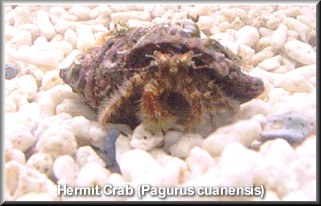 |
 |
Man's Impact
To see into the future, it is essential to have a clear vision of the
present. How have man's activities affected the marine environment, and
especially the zone between the high and low tides? This is a difficult
question to answer succinctly. I think, generally, that the wildlife habitats
of the seashore have changed detrimentally to a much lesser extent than
any other terrain. And this is probably due to the nature and difficulties
of exploiting the resources. In other words, the collection of prawns,
shrimps, worms for bait, winkles, mussels, cockles,
razorfish and aquarium exhibits etc. requires considerable time and
effort, and a little bit of practice and technique, so it is only enjoyed
by a few people who have a general interest in the seashore. There is no
money to be made, and in many cases the energy expended in prawning or
shrimping exceeds the rewards in food terms.
 Periwinkles
and Dogwhelks on a rocky
shore
Periwinkles
and Dogwhelks on a rocky
shoreAll this means that rocky shores, the ones of most interest to the 'rockpooler', have always been regarded as having little value, which has had the advantage that they were generally ignored by the public, and therein lies their wildness and source of interest.
However, there was one small drawback. Because these shores were regarded as being of insignificant value, some were treated with disdain, and this is demonstrated by sewage outlets that discharge straight on to rocky shores.
Minority Group
Rockpoolers are a minority group and I think this is likely always to remain so. However, we are the major group with a vested interest in the seashore, from the small 'critters' and attractive sea anemones to the higher vertebrate animals like the small rock pool fish and the marauding sea birds. By bringing to the attention of the general public the magical world of small marine creatures, we are increasing the profile of this wildlife habitat.
By stimulating interest, we can increase the amenity value of rocky shores, and, hopefully, prevent some of the pollution abuses. e.g. only bathing areas are on the agenda for the 'blue flag' award for clean beaches. It may well be that eating contaminated seafood is a far greater danger than swimming in sewage-laden seas.
Dangers
On the whole, I believe that by publishing information about the wildlife of the seashore, we are likely to create a greater respect for this environment and the fascinating creatures that live between the tides. At present some shores can resemble a dumping ground for waste products and the packaging discards of this throwaway society.
The Seven Sisters from Seaford head, East Sussex coastline
This is not always a problem for marine life. Blennies happily make a home for themselves in discarded coke cans. Plastic sheeting found in the sea off Dawlish, Devon, is reported by fishermen to be the only known habitat in the area for the uncommon sea anemone Hormathia coronata.
Warning
However, there is one word of warning. In Victorian times, publicity by Philip Henry Gosse, who established the first aquarium, and shipped seawater to London Zoo on the first trains, introduced the urban public to the creatures of the sea. The result was hordes of holidaymakers descending to the rock pools and stripping them of their rich life. The craze did not last long. Most of the early aquaria failed dismally.
Sussex Coast
On the Sussex coast, the most interesting finds have to be searched for, and this often involves a diligence and patience not shown by most people. Therefore, it is not envisaged that collectors could destroy this habitat. The coastline stretches for 6095 miles plus around the British Isles; many of the shores are rocky, and most would not be vulnerable to casual visitors.
However, some people have a herd instinct that compels them all to visit the same place. Some special coasts that contain a particularly rich and varied flora and fauna of scientific interest, especially in the south-west, could be vulnerable to collection of rare species, or just be damaged by the sheer number of visitors. One selfish irresponsible collector could conceivably spoil the right of other 'rockpoolers' to enjoy nature in its wild state.
Rules
The conventional method of 'rockpooling', and collecting softback crabs for bait, involves descending down to the shore when the tide is out and turning over rocks. It is important that the rocks are returned in the same position and the same way up in which they were found, because much of the invertebrate life like sponges and tubeworms could be destroyed by a rock carelessly tossed aside. Even small fish exposed by a moved rock could fall prey to the scavenging gulls.
Coastal Code
We have adopted the Coastal Code originally used by the Nature Conservancy Council (now English Nature) and adapted it to make a clearer read.
In Marine Conservation Areas, as part of the wardening and management programme, visitors are discouraged from taking home live animals, and not to even touch the creatures of the shore in case they are inadvertently killed (a small rock fish can be crushed to death if picked up by small fingers; the 'rockpoolers' method is to cup the hand and tease the fish into it). Rockpoolers can usually find alternative areas to visit, and for the most part, collection on a modest scale has no detrimental affect.

The number of niches has a great bearing on the populations, for example
the number of crabs is determined by the number
of rocks to hide under, and the number of urchins may be directly related
to the food supply. Collection pales into insignificance (with the possible
exception of over-exploitation of periwinkles) compared to large scale
oil pollution and habitat alteration by such activities as offshore dredging.
|
|
|
|
|
|
|
|